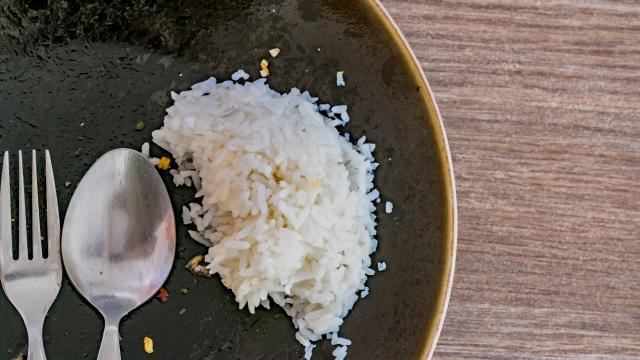Lurking inside your reheated fried rice is a dangerous bacterial killer—at least, that’s what you might think after watching one of the latest viral videos shared on TikTok and other social media platforms. There is a grain of truth to this claim, and you should try to properly store your leftovers, but the risks of so-called fried rice syndrome shouldn’t be overblown.
The tale of fried rice syndrome pops up online every once in a while, more recently in a TikTok video from cooking and home goods company Food52, posted last week. In the video, food editor Emily Ziemski discusses the tiny culprit behind the syndrome, Bacillus cereus. And to Ziemski’s credit, the gist of the video is accurate.
The Hardy Germ
B. cereus, a close relative of the bacteria responsible for anthrax, is a well-known cause of food poisoning. Disease-causing strains of B. cereus produce a number of toxins when actively growing, and it’s these toxins that actually make people sick. There are two main forms of foodborne B. cereus illness, with slightly different symptoms. In one, you get sick from the toxins produced by the bacteria once they get inside and infect you; in the other, you get sick from already-produced toxins that you ingest.
B. cereus bacteria are ubiquitous in the environment, particularly in soil, so they can easily end up in our food supply. And though they can be caught from a variety of foods like dairy, beef, and vegetables, the illness they cause is often associated with reheated fried rice and other leftovers, for a good reason. These bacteria can shape-shift into a spore-like form to survive inhospitable environments, including very cold and hot temperatures. Once the conditions are ripe again, they start growing and producing toxins en masse. So cases of sickness do tend to be linked to improperly stored foods.
A common scenario goes like this: You leave an unfinished bowl of rice that was at some point contaminated with B. cereus spores sitting out on the kitchen counter for a few hours. During that time, the bacteria break free and grow to their heart’s content. If the person eats the food then and there, they can get infected and soon enough sickened by the bacteria’s toxins. And even if they reheat the rice to kill all the active bacteria, there’s one particular heat-resistant B. cereus toxin that can linger in the food and make us sick that way.
According to expert guidelines on B. cereus prevention, foods are in the “danger zone” for contamination when they’re left alone for extended periods of time at temperatures ranging from 41 to 135 degrees Fahrenheit. So hot foods meant to be held for a while should be maintained at temperatures above that, and in general, cooked foods destined to be leftovers (especially meat) shouldn’t be left out at room temperature for more than two hours.
At the same time, the TikTok video might give you the impression that leftover rice will inevitably make you seriously sick if it’s kept out even a smidge too long, and that’s not quite right either.
A Real but Modest Nuisance
For starters, while the typical symptoms of B. cereus illness are unpleasant (either nausea, vomiting, and cramps or diarrhea, depending on the type you get), they’re relatively mild, with most cases clearing up on their own within a day. B. cereus can cause severe, even fatal illness, but only rarely and usually under specific circumstances, like someone having a weakened immune system. The nastiness of a case can also depend on factors like the amount of bacteria or toxin that a person ingests. In one notorious case that received renewed attention last fall, for instance, a 20-year-old man is believed to have died from eating B. cereus-contaminated pasta that was left at room temperature for a whopping five days before he reheated it.
It’s not particularly common in the U.S., either. According to a 2011 study from the Centers for Disease Control and Prevention, roughly 63,000 cases of foodborne B. cereus are estimated to occur annually in the U.S., along with 20 hospitalisations (the study also estimates zero yearly deaths on average, but these still might happen from time to time). For comparison, the single most common foodborne infection—norovirus—is thought to cause about 5.5 million cases of food poisoning every year.
All that said, B. cereus illness can and does happen often enough to be a genuine public health concern. Contrary to the speculation of many commentators on Food52’s TikTok and other social media posts, people in rice-loving parts of the world like Asia are not immune to it.
According to a 2020 study from China’s CDC, for instance, B. cereus was the fourthmost bacterial cause of foodborne outbreaks with a known culprit in the country between 2003 and 2017. Another paper published last year found that there were more than 400 reported outbreaks of B. cereus within China from 2010 to 2020, which led to at least 7,892 cases, 2,786 hospital admissions, and five deaths (as is often true with foodborne illness, the actual number of cases is likely higher).
As for why some people can readily believe that no one ever gets sick from leftover rice, the answer is probably simple. Tummy aches and other gastro symptoms are a common feature of life. And unless it was an especially bad bout of food poisoning, we might just easily forget mundane episodes that happened to us or our loved ones, or even mistakenly blame the wrong meal when we do remember them.
So yes, you should be careful about how you refrigerate and reheat your foods, especially if you have a health condition that makes you more vulnerable to foodborne infections in general. And you should definitely throw out the five-day-old takeaway container left on the kitchen counter. But, barring extreme circumstances, there are much deadlier things out there than your typical bowl of reheated rice.
